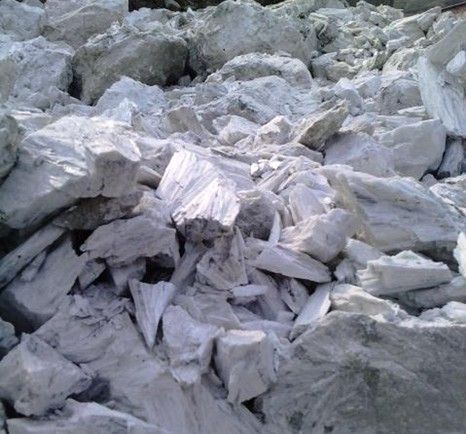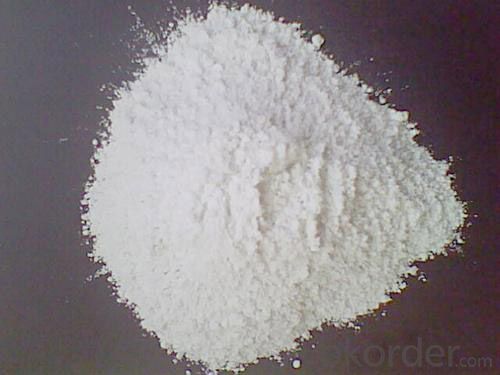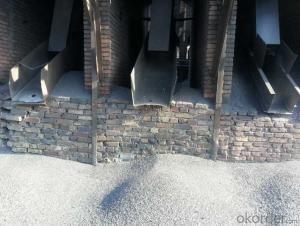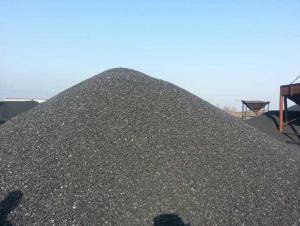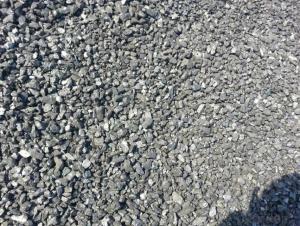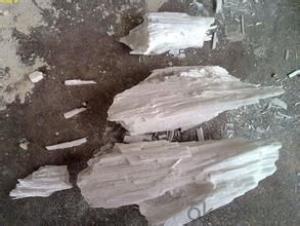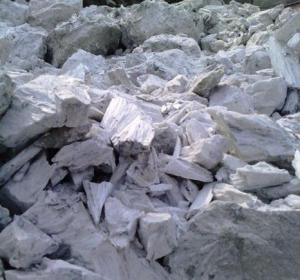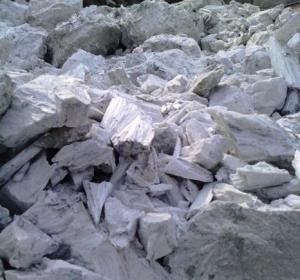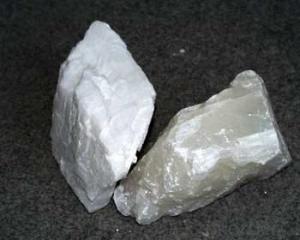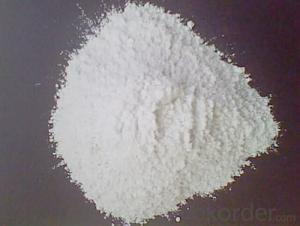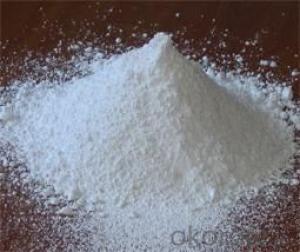Wollastonite under different grade and different size
- Loading Port:
- Tianjin
- Payment Terms:
- TT OR LC
- Min Order Qty:
- 20 m.t.
- Supply Capability:
- 3000 m.t./month
OKorder Service Pledge
OKorder Financial Service
You Might Also Like
USAGE:
Wollastonite is widely used in ceramic, coatings, plastics, rubber, welding, chemical, metallurgy, construction, automobile ,asbestos substitutes and paper industry . We can supply different grades of wollastonite powder, Acicular Wollastonite and other formal product.
Wollastonite
Cas no: 13983-17-0
1*20 FCL can load about 25-27 tons.
Brief Introduction of Our Products Wollastonite:The formula of Wollastonite is CaSiO3.The ideal chemicalspecifications are as followed:SiO2 :51.75% ; CaO:48.25% , heated-Swelling,
Coefficient:6.5*10-6°C-1, Moh's Hardness 4.5-5.0 , Density:2.8 , melting Point 1540°C , Refraction Index 1.62
It is mainly used in produces Coatings , plastics , Ceramic and building materials
SPECIFICATION OF CERAMICS GRADE
DescriptionWhite powder
ItemsSiO2 %CaO %MgO %Fe2O3 % S %P %Al2O3Loss %
Grade A≥49≥46≤0.8 ≤0.3≤0.01≤0.01 ≤ 0.8≤1.5
Grade B≥50 ≥43≤0.8 ≤0.3≤ 0.01≤0.01 ≤ 0.8≤3
Grade C≥51≥40≤0.8≤0.35≤ 0.01≤0.01≤ 0.8≤5
Size80-400 mesh or as request
Specification for Metallurgical Grade
ItemsSiO2 %CaO %MgO %Fe2O3 % S % P %Loss %White Grade
Grade A45-5638-43≤0.8≤ 0.2≤0.001≤0.0014.5-5.5 ≥80
Grade B49-5144-46≤0.8≤ 0.2≤0.001≤0.0011-2.5 ≥85
Size: From 80 mesh to 400mesh or adjusted according to customer’s request
4: Picture

- Q: How does a kebab cook at home?
- Do you have long fire sticks in your house?...... Yes, just a carbon and burn it over the gas stove...... If not, apply a little oil underneath......Burn, put carbon on the top, pay attention to leave the gap, do not suppress it.
- Q: What is fullerene?
- Fullerene refers to a molecule made entirely of carbon atoms, arranged in a unique structure resembling a hollow cage or sphere. It is a form of allotrope of carbon, alongside graphite and diamond. The most common and well-known fullerene is called buckminsterfullerene, or simply C60, which consists of 60 carbon atoms arranged in a soccer ball-like shape. Fullerenes can also vary in size, ranging from as few as 20 carbon atoms to several hundred. They can be found naturally in soot and formed through various methods, such as laser ablation or chemical vapor deposition. Due to their distinctive structure, fullerenes possess remarkable properties, including high strength, low density, and excellent electrical and thermal conductivity. They have found applications in various fields, including nanotechnology, electronics, medicine, and materials science.
- Q: What is the carbon emission of the air conditioner?
- Summer, less air-conditioning, 1 hours to reduce carbon emissions of 0.621kg, the action of the low carbon family is not how much money you need to pay, but to change some of your habits and habits, and contribute to environmental protection. Hand in hand to join hands to tackle climate warming, perhaps our hearts will be less worried about the future......
- Q: How does carbon contribute to global warming?
- The greenhouse effect, caused by carbon, contributes to global warming. When carbon dioxide (CO2) and other greenhouse gases are released into the atmosphere, they trap heat from the sun, preventing its escape into space. As a result, the Earth's surface temperature increases and global warming occurs. The primary cause of carbon emissions is the burning of fossil fuels such as coal, oil, and natural gas for energy production, transportation, and industrial processes. These activities release significant amounts of CO2 into the atmosphere, which accumulates over time and intensifies the greenhouse effect. Deforestation and changes in land use also play a role in rising carbon levels. Trees and plants absorb CO2 through photosynthesis, acting as a natural carbon sink. However, when forests are cleared, the stored carbon is released back into the atmosphere. Additionally, the loss of trees reduces the overall capacity for CO2 absorption, aggravating the problem. The consequences of increased carbon emissions are extensive. Rising temperatures lead to the melting of polar ice caps and glaciers, resulting in sea-level rise and posing a threat to coastal communities. Moreover, carbon-driven global warming disrupts weather patterns, giving rise to extreme weather events like hurricanes, droughts, and heatwaves. To mitigate the impact of carbon on global warming, efforts must be made to reduce carbon emissions. This can be accomplished by transitioning to renewable energy sources such as solar and wind power, enhancing energy efficiency, promoting sustainable practices in agriculture and forestry, and implementing policies that encourage carbon capture and storage. Addressing carbon emissions is vital in combating global warming and its associated consequences. By comprehending the role of carbon in the greenhouse effect, we can work towards a sustainable future that minimizes the adverse effects of climate change.
- Q: How does carbon contribute to the strength of composite materials?
- Carbon contributes to the strength of composite materials through its unique properties and ability to form strong chemical bonds. When carbon is used in the form of carbon fibers or nanoparticles, it provides high tensile strength and stiffness to the composite material. Carbon fibers are exceptionally strong and lightweight, making them ideal for reinforcing composite materials. These fibers are made up of long, thin strands of carbon atoms that are tightly packed and aligned in a specific direction. When embedded in a matrix material, such as epoxy resin, the carbon fibers distribute stress evenly throughout the composite, increasing its overall strength. The strong chemical bonds between carbon atoms also contribute to the strength of composites. Carbon atoms can form covalent bonds, which are very strong and stable. These bonds allow carbon to withstand high levels of stress and deformation without breaking, making it an excellent reinforcement material. Furthermore, carbon's high thermal conductivity allows it to efficiently transfer heat away from the composite material, preventing overheating and potential damage. This property is particularly important in applications where temperature fluctuations or high heat dissipation are involved, such as aerospace or automotive industries. Overall, carbon's unique properties, including its high tensile strength, stiffness, strong chemical bonds, and thermal conductivity, make it an essential component in enhancing the strength and performance of composite materials.
- Q: What are the different types of carbon-based pigments?
- Various industries widely use several different types of carbon-based pigments. Some of the most commonly used types are carbon black, graphite, charcoal, and lampblack. Carbon black, renowned for its intense black color, is a highly pure form of carbon produced through the incomplete combustion of hydrocarbon fuels. It finds extensive applications in inks, paints, plastics, and rubber products. Graphite, on the other hand, is an important carbon-based pigment known for its dark gray to black shade. It is a brittle material that can be easily crushed into a fine powder. Graphite is primarily used in pencils due to its ability to leave a smooth and consistent mark on paper. Additionally, it finds utility in lubricants, batteries, and electrical conductors. Charcoal, obtained by burning wood or organic materials without oxygen, is a carbon-based pigment admired for its deep black color. Artists commonly use charcoal as a drawing medium because it can be easily manipulated and smudged on paper, allowing for the creation of various tones and textures. Lampblack, also referred to as carbon black or soot, is a pigment produced by burning organic materials like oil or wood. It possesses a profound black hue and is frequently employed in printing inks, coatings, and dyes. Lampblack is also utilized in diverse industrial applications, including as a coloring agent in plastics and rubber products. These examples represent only a fraction of the diverse carbon-based pigments commonly employed. Each type possesses unique attributes and serves essential purposes in various industries.
- Q: What are the implications of melting permafrost on carbon emissions?
- The melting of permafrost has significant and concerning implications for carbon emissions. Permafrost, which is permanently frozen ground found in cold regions, consists of soil, rocks, and organic matter. It acts as a large carbon sink, storing vast amounts of organic material, such as dead plants and animals, which have been frozen for thousands of years. However, as global temperatures rise, permafrost is thawing at an alarming rate, which could potentially release this stored carbon into the atmosphere. When permafrost thaws, the organic matter contained within it decomposes, releasing greenhouse gases, particularly carbon dioxide (CO2) and methane (CH4), into the atmosphere. Methane is an extremely potent greenhouse gas, with a global warming potential over 25 times greater than that of CO2 over a 100-year period. The release of these gases further contributes to climate change, exacerbating the already accelerating warming trend. The implications of melting permafrost on carbon emissions are twofold. Firstly, the release of large amounts of CO2 and methane from thawing permafrost can significantly amplify the greenhouse effect, leading to more rapid and intense climate change. This can create a feedback loop, where increased warming causes more permafrost thawing, releasing more carbon, and further accelerating global warming. Secondly, the release of carbon from permafrost also affects global carbon budgets and efforts to mitigate climate change. The amount of stored carbon in permafrost is estimated to be twice as much as what is currently present in the Earth's atmosphere. As this carbon is released, it adds to overall carbon emissions, making it more challenging to achieve emission reduction targets outlined in international agreements, such as the Paris Agreement. It also means that efforts to limit global warming to well below 2 degrees Celsius above pre-industrial levels become even more crucial. Moreover, the release of carbon from permafrost also has implications for local ecosystems and communities. Thawing permafrost can lead to the destabilization of infrastructure, including buildings, roads, and pipelines, as well as disrupt traditional livelihoods, such as hunting and reindeer herding. It can also cause land subsidence and increased coastal erosion, posing threats to coastal communities and biodiversity. In conclusion, the implications of melting permafrost on carbon emissions are extensive. It not only exacerbates climate change by releasing potent greenhouse gases into the atmosphere but also hinders global efforts to mitigate carbon emissions. Taking sustainable actions to reduce greenhouse gas emissions and protect permafrost ecosystems are vital to minimize these implications and safeguard the future of our planet.
- Q: What is carbon dioxide?
- Carbon dioxide (CO2) is a colorless and odorless gas that consists of carbon and oxygen atoms. It is formed through the combustion of fossil fuels, as well as the natural processes of respiration and volcanic activity. Carbon dioxide plays a crucial role in the Earth's atmosphere as a greenhouse gas, trapping heat and contributing to the planet's overall temperature. While it occurs naturally, human activities such as burning of fossil fuels and deforestation have significantly increased its concentration in the atmosphere, leading to global warming and climate change. Carbon dioxide is also a byproduct of various industrial processes, such as cement production and power generation. Efforts to reduce carbon dioxide emissions are essential to mitigate the effects of climate change and maintain a sustainable environment.
- Q: What is carbon pricing?
- Carbon pricing is a market-based strategy aimed at reducing greenhouse gas emissions by putting a price on carbon dioxide and other greenhouse gases. It involves either implementing a tax on carbon emissions or establishing a cap-and-trade system where companies are allotted a certain amount of emissions permits that can be bought and sold. The goal is to create financial incentives for industries to reduce their emissions and transition to cleaner and more sustainable practices.
- Q: How is carbon used in the production of paints?
- Paint production utilizes carbon in multiple ways. An important application of carbon in paint production involves its use as a pigment. Carbon black, a type of elemental carbon, is commonly employed as a black pigment in various paint types. It imparts a deep and intense black hue, along with exceptional light absorption characteristics, making it ideal for creating dark tones in paints. Additionally, carbon plays a role in the formulation of specific paint types, such as carbon-based coatings. These coatings find application in scenarios demanding resistance against heat, chemicals, and corrosion. Industries like automotive, aerospace, and marine frequently employ carbon-based coatings, where durability and protection are paramount. These coatings can be applied to diverse surfaces, providing a high level of protection and extending the lifespan of the painted object. Furthermore, carbon serves as a filler material in certain paint varieties. Carbon fillers are added to enhance the mechanical properties of the paint, including strength, hardness, and resistance to wear and tear. They also contribute to the overall performance of the paint, augmenting its durability and longevity. In conclusion, carbon is an indispensable component in paint manufacturing, fulfilling roles as a pigment, a constituent of coatings, and a filler material. Its versatile properties make it a valuable addition to various paint formulations, enhancing the aesthetic appeal, durability, and performance of the final product.
Send your message to us
Wollastonite under different grade and different size
- Loading Port:
- Tianjin
- Payment Terms:
- TT OR LC
- Min Order Qty:
- 20 m.t.
- Supply Capability:
- 3000 m.t./month
OKorder Service Pledge
OKorder Financial Service
Similar products
Hot products
Hot Searches
Related keywords


